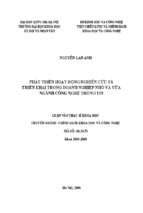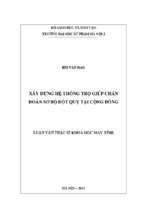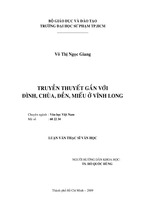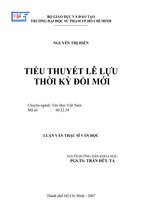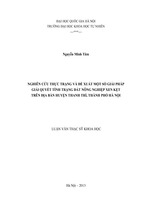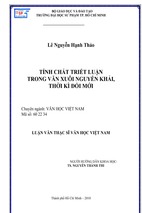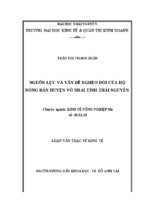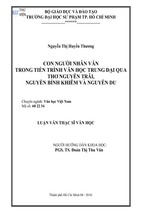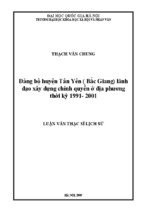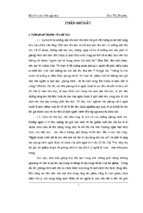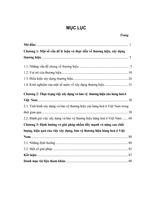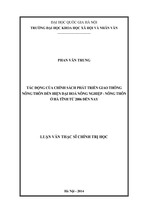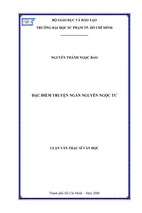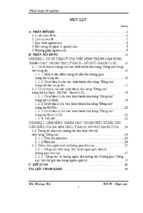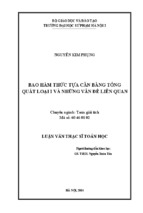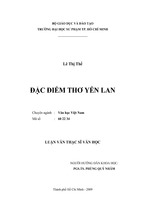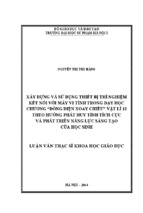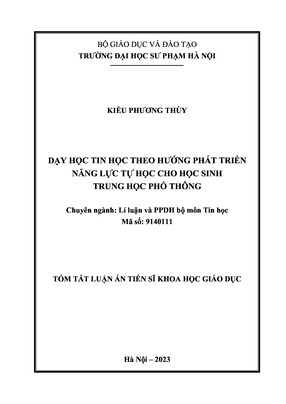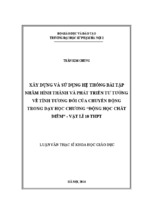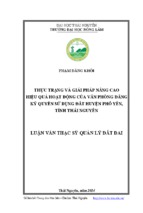VIETNAM NATIONAL UNIVERSITY - HA NOI
UNIVERSITY OF LANGUAGES AND INTERNATIONAL STUDIES
FACULTY OF POST-GRADUATE STUDIES
********************
NGUYỄN THỊ HƯỜNG
A STUDY OF POLITENESS STRATEGIES IN THE
CONVERSATION ACTIVITIES OF THE COURSE BOOK
NEW HEADWAY – ELEMENTARY
(NGHIÊN CỨU CHIẾN LƯỢC LỊCH SỰ TRONG HOẠT ĐỘNG
GIAO TIẾP CỦA GIÁO TRÌNH NEW HEADWAY - ELEMENTARY)
M.A. MINOR PROGRAMME THESIS
Field: English Teaching Methodology
Code: 60140111
HA NOI - 2017
VIETNAM NATIONAL UNIVERSITY - HA NOI
UNIVERSITY OF LANGUAGES AND INTERNATIONAL STUDIES
FACULTY OF POST-GRADUATE STUDIES
********************
NGUYỄN THỊ HƯỜNG
A STUDY OF POLITENESS STRATEGIES IN THE
CONVERSATION ACTIVITIES OF THE COURSE BOOK
NEW HEADWAY – ELEMENTARY
(NGHIÊN CỨU CHIẾN LƯỢC LỊCH SỰ TRONG HOẠT ĐỘNG
GIAO TIẾP CỦA GIÁO TRÌNH NEW HEADWAY - ELEMENTARY)
M.A. MINOR PROGRAMME THESIS
Field: English Teaching Methodology
Code: 60140111
Supervisor: Prof. Dr. Nguyễn Quang
HA NOI - 2017
DECLARATION
I here y st te th t I: Nguy n Thi Hường, from QH2015.E3, being a candidate
for the degree of Master of Arts (MA), accept the requirements of the university
rel ting to the retention nd use of M ster‘s Gr du tion P per deposited in the
library.
In terms of these conditions, I agree that the origin of my paper deposited in
the library should be accessible for the purposes of study and research, in
accordance with the normal conditions established by the librarian for the care, loan
and reproduction of the paper.
October, 1st 2017
N
i
ễ
H
ACKNOWLEDGEMENTS
It is an honor for me to express my deep and sincere thanks to those who have
made this thesis possible.
First of all, I would like to pay my great gratitude to my supervisor, Prof. Dr.
Nguy n Quang, for his continuous support, careful guidance and valuable advice
throughout my thesis-writing period. With his comprehensive instruction, his
inspiration, enthusiasm and immense knowledge, he helped me step by step write
up my thesis to the best of my ability and opened my knowledge of literature. It was
very lucky for me to be under his guidance.
My heartfelt thanks and blessings also go to my family, especially my parents
who are always by my side and support me during the time I did my thesis. Their
well-being is of great spiritual motivation for me all the time.
Last but not least, I want to offer special thanks to all of my friends who
always supported and stood by me during the completion of the graduation paper.
To them all I dedicate this thesis.
ii
ABSTRACT
English has been an indepensible means of communnication in daily life.
However, in fact, a large number of English learners find it hard to communicate
fluently and confidently. Therefore, it is essential to find out ways to interact well in
daily communication which are partly presented in the politeness strategies used
during the process of interaction. As a result, this study is carried to find out
politeness strategies and how they work in communication. All converational
ctivities in the course ook ―New He dw y – Element ry‖ are examined. Then the
data is analyzed according to two types of strategies, the positive and negative ones.
The research results reveal that positive politeness strategies are used much more
than negative politeness strategies found in most of conversations in the book.
Furthermore, twelve positive politeness strategies and six nagative posliteness
strategies are used in the book. Finally, implications are offered for teaching and
learning English with consideration to politeness strategies in communication.
iii
TABLE OF CONTENTS
DECLARATION ………………………………………………………..
i
ACKNOWLEDGEMENTS ...…………………………………………..
ii
ABSTRACT ……………………………………………………………..
iii
TABLE OF CONTENTS ………………………………………………..
iv
LIST OF FIGURES AND TABLES …………………………………….
vi
LIST OF APPENDICES ..……………………………………………….
vi
LIST OF ABBREVIATIONS .………………………………………….
vii
CHAPTER 1: INTRODUCTION
1.1. Statement of research problem and the rationale for the study ....................1
1.2. Aim and significance of the study .....................................................................2
1.3. Objectives of study .............................................................................................2
1.4. Scope of study .....................................................................................................2
1.5. Design of the study.............................................................................................3
CHAPTER 2: LITERATURE REVIEW
2.1. Culture and Communication .............................................................................4
2.1.1. Definition of culture .....................................................................................4
2.1.2. Definition of communication .......................................................................4
2.1.3. The relationship between culture and communication ...............................5
2.2. Politeness .............................................................................................................5
2.2.1. What is politeness? .......................................................................................5
2.2.2. Previous studies on politeness ......................................................................8
2.2.3. Positive politeness and positive politeness strategies ..................................9
2.2.4. Negative politeness and negative politeness strategies..............................14
iv
CHAPTER 3: METHODOLOGY
3.1. Data source ........................................................................................................18
3.2. Methods .............................................................................................................18
3.2.1. Techniques for data collection ...................................................................19
3.2.2. Techniques for data analysis ......................................................................19
3.2.3. Process of data analysis ..............................................................................19
CHAPTER 4: FINDINGS AND DISCUSSIONS
4.1. Frequency of positive and negative politeness strategies in the
conversational activities .....................................................................................20
4.2. Positive politeness strategies in the conversational activities .......................21
4.3. Negative politeness strategies in the conversational ......................................26
CHAPTER 5: CONCLUSION
5.1. Summary of the findings ..................................................................................30
5.2. Implications to English teaching and learning ..............................................31
5.3. Limitation of the study and Reccomendations for further research ...........31
REFERENCES .............................................................................................. 33
APPENDICES ..................................................................................................I
v
LIST OF FIGURES
Figure 1: Circumstances determining choice of strategy (Brown and Levinson,
1978, 60)
Figure 2: Strategies to minimize risk of losing face (Nguyen Quang, 2001)
Figure 3: The frequency of positive politeness strategies
Figure 4: The frequency of negative politeness strategies
LIST OF TABLES
Table 1. The statistics of positive and negative politeness strategies
Table 2. The statistics of positive politeness strategies
Table 3. The statistics of negative politeness strategies
LIST OF APPENDICES
APPENDIX: Summary of positive and negative politeness strategies in the course
ook ―new he dw y – element ry‖
vi
LIST OF ABBREVIATIONS
S: Speaker
H: Hearer
FTA: Face Threatening Act
PPS: Positive Politeness Strategies
NPS: Negative Politeness Strategies
T: Track
P: Page
vii
CHAPTER 1: INTRODUCTION
1.1. Statement of research problem and rationale for the study
People are probably unable to communicate well in their daily life, without
language which is regarded as the most popular means of communication to
exchange information among people at work or in study. Although there have been
over 10,000 languages available in the world, some of them have been used as the
common languages and only few have been spoken widely around the world.
English is a language which many countries use as a first language and many have
considered it as the common language for teaching in schools and universities.
People have studied English for different purposes such as getting job, studying
abroard, promotion or travelling.
In Vietnam, English has been taught as a foreign language for serveral
decades and recently, English has become a compulsory subject in most schools,
colleges and universities. Although teaching speaking skill as well as other skills
have been put in all the textbooks from primary school to high school for several
years, most Vietnamese teachers have still focused on teaching grammar like
structural rules and forms of tenses rather than speaking skill. This accidentally
makes a large number of students learning English but unable able to make
everyday conversations well when they meet foreigners who speak English.
Besides, many Vietnamese are afraid of talking in English because they do not
know how to appear polite in English. Therefore, this study is conducted with the
hope to point out how positive and negative politeness strategies are used in the
conversational activities under investigation, thus helping to improve the teaching
nd le rning of ―Everyd y English‖ in the course book New Headway –
Elementary, by Liz & John Soars.
1
1.2. Aim and significance of the study
This research aims to r ise Vietn mese le rner‘s w reness of how to use
politeness strategies appropriately in order to achieve successful communication.
Moreover, the study expects to put forward some suggestions for the teaching of
positive and negative polite strategies to language teachers. Hence, as this thesis
completed, it can be beneficial for both theoretical and practical contributions. In
terms of theoretical significance, this study contributes to making explicit the
important role of politeness strategies in verbal communication, especially in crosscultural communication. For practical significance: This study helps gain an insight
into the method employable for teaching politeness strategies in the course book
―New He dw y - Element ry‖ s well s in djustment nd pplic tion of te ching
techniques.
1.3. Objectives of the study
This thesis is conducted with two main objectives. Firstly, the author comes to
investigate positive and negative politeness in most typical contextual environments
in ―Everyd y English‖ of the course ook New He dw y – Elementary. In addition,
the second purpose is to collect and analyze the extent to what politeness strategies
are recruited and distributed in the coursebook. In brief, these objectives can be
achieved through finding tentative answers to the following research questions:
1. How are positive politeness strategies used in the “Everyday English
activities”of the course book “ New Headway – Elementary”?
2. How are negative politeness strategies used in the “Everyday English
activities”of the course book “ New Headway – Elementary”?
1.4. Scope of the study
The study investigates the use of positive and negative politeness strategies only
in the conversational activities of ―Everyd y English‖ in 14 units presented in the
course book New Headway – Elementary written by Liz & John Soars.
2
1.5. Design of the study
The study consists of five chapters. Chapter 1 (Introduction) presents the
rationale, the objectives, significance and the scope of the study. Literature of
culture, communication, politeness and politeness strategies are reviewed in
chapter 2. Chapter 3 disscusses methodology of the study with research questions,
the participants, the method for data collection and data analysis. In chapter 4, data
are analyzed and findings are discussed towards research questions 2 and 3.
Finally, chapter 5 summarizes the main finding of the study, pointing out some
limitations of the research, offering implications for English teaching and learning,
and giving recommemdations for further research.
3
CHAPTER 2: LITERATURE REVIEW
2.1. Culture and Communication
2.1.1. Definition of culture
Levine
nd Adelm n (cited in Nguy n Qu ng, 2002: 30-31) hold that
―culture is a share background (for example, national, ethnic, religious) resulting
from a common language and communication style, customs, beliefs, attitudes, and
values‖. ―Culture‖ in this study does not refer to art, music, literature, food, clothing
styles, and so on. It refers to the informal and often hidden patterns of human
interactions, expressions, and viewpoints that people in one culture share. The
hidden nature of culture has been compared to an iceberg, most of which is hidden
underwater! Like the iceberg most of the influence of the culture on an individual
cannot be seen. The part of culture that is exposed is not always that which creates
cross-cultural difficulties; the hidden aspects of the culture have significant effects
on behaviour and on interactions with others.
According to Phillip K. Bock (cited in Nguyen Thi Tuyet, 2005: 3), culture is
considered ―in its broadest sense, as what makes you a stranger when you are away
from home. It includes all those beliefs and expectations about how people should
speak and act, which have become a kind of second nature to one as a result of
social learning. When you are with members of a group who share your culture,
you do not have think about it, for you are all viewing the world in pretty muach the
same way and you all know, in general terms, what to expect of one another‖.
Banks (1989: 8) also shares a very remarkable notion of culture in which
he claims that “the essence of culture is not its artifacts, tools or other tangible
culture elements but how the members of the group interpret, use and perceive.‖
2.1.2. Definition of communication
The term ―communic tion‖ h s
lre dy included many definitions with
emphasis on various factors. Hybels and Weaver (2001: 5) defined communication
as ―any process in which people share information, ideas, and feelings that involve
4
not only the spoken and written words but also language, personal mannerism and
style, the surrounding and things that add meaning to a message.‖
Nguyen Quang (1998: 3) states that ―Communnication is the process of
sharing meaning through verbal and nonverbal behaviour.‖
2.1.3. The relationship between culture and communication
There has always existed the close relationship between culture and
communication; that means, culture creates communication and communication in
its turns reflects culture. Without communication, it would not be possible to see
and interpret how culture manifests itself intraculturally and interculturally.
Samovar (1981: 20) points out the close-knit relationship between these two
factors in inter ction ―Culture and communication are inseparable because
culture not only dictates who talks to whom, about what and how the
communication proceeds, it also helps to determine how people encode
messages, the meanings they have for messages, and the conditions and
circumstances under which various messages may or may not be sent, noticed or
interpreted. Culture is the foundation of communication‖. It is revealed from
S mov r‘s opinion th t culture and communication got are reciprocally
supportive in which culture is the cradle to nourish communication and
communication comes back to be the paddle for the development and
maintenance of culture.
2.2. Politeness
2.2.1 What is politeness?
Politeness is an important construct in the studies of communication and
pragmatics, especially in cross – cultural communication. Hence, it is obvious that
there have been lots of definitions and conceptualisations of politeness extended by
many scholars.
According to Blum-Kulla (1983: 131), politeness linguistically refers to ―the
interactional balance achieved between two needs: the need for pragmatic clarity
and the need to avoid coerciveness”,
5
Thomas (1995: 157) gives another opinion of politeness, politeness is
understood as “strategies (or series of strategies) employed by a speaker to achieve
a variety of goals, such as promoting or maintaining harmonious relation”.
Holmes (1992: 296) points out in her book An Introduction to
Sociolinguistics th t politeness includes t king ccount of other people‘s feeling in
order to make himself comfortable.
Nguy n Qu ng (2004: 11) functionally claims that “Politeness is any
communicative act (verbal and/or nonverbal) which is intentionally and
appropriately meant to make other(s) feel better or less bad”.
Generally, most of the scholars share the view that politeness is any
behaviour in communication that the is resorted to the im to s tisfy the he rer‘s or
at to make the hearers feel better or less bad.
Face
It is undeniable that the realisation of politeness in communication partly
relates to the public self-image of the participants. Brown and Levinson (1987)
mention this image in their research which is referred to s ―f ce‖. ―Face is the
public-self image that every member wants to claim for himself‖ (Brown and
Levinson, 1987: 61). In addition, these authors classify face into two types:
negative face and positive face.
Negative face focuses on the basic claim to
territories, personal preserves, rights to non-distraction while positive face concerns
with the positive consistent self-image or ‗person lity‘(cruci lly including the
desire that this self-image be appreciated and approved of) claimed by interactants.
In daily communication, it is possible to exist both dimensions: one is respect
for face as norms or values subscribed to by members of a society which is called
face as want, the other dimension runs contrary to the face wants of the addressee
and/or of the speaker which is defined as Face-Threatening Act (FTA). Brown and
Levinson (1987: 60) suggest five common strategies to deal with FTA, these
stratetegies are illustrated in Figure 1 below:
6
Lesser risk
Estimation of risk
of face loss
Do the
FTA
5. Don’t
do the
FTA
On
record
1. Without redressive action,
badly
4. Off
record
With
redressive
action
Greater risk
Figure 1: Circumstances determining choice of strategy
2.
Positive
Politenes
s
3.
Negative
Politenes
s
(Brown and Levinson, 1978, 60)
Nguyen Quang (2002) comments that this view by Brown and Levinson is more or
less eurocentric and thus decreasing their di gr m‘s univers l v lue. Therefore, he
proposes the following figure:
FTA encounter
3. Do not do the FTA
Do the FTA
On record
2. With redressive action
2. Off record
Positive politeness
Negative politeness
1. Without redressive action/ On
record
Figure 2: Strategies to minimize risk of losing face (Nguyen Quang, 2001)
7
2.2.2. Previous studies on politeness
There has been a variety of studies conducted to investigate politeness by
various scholars through out the years. That could list Lakoff (1973, 1990), Leech
(1983), Watts (1989), Frazer (1990), Cruse (2000), Eelen (2001, Watts (2003)…
Lakoff (1973: 296) is one of the pioneers to adopt Grice's construct
of Conversational Principles in an effort to account for politeness. She
explicitly extends the notion of
grammatical rule to the domain of
politeness and considers the form of sentences.
Leech (1983: 82) introduces the politeness principle whose function is to
maintain the social equilibrium and the friendly relations and to assume that our
interlocutors are being cooperative in the first place.
Watts (1989: 19) identifies politeness as linguistic behaviour which
is perceived to be beyond what is expectable. Politeness is viewed as explicitly
marked, conventionally interpretable subset of 'politic' responsible for the smooth
functioning of socio-communicative interaction and the consequent production of
well-formed discourse within open social groups characterized by elaborated speech
codes.
Lakoff (1990: 34) sees politeness as "a system of interpersonal relations
designed to facilitate interaction by minimizing the potential for conflict and
confrontation inherent in all human interchange‖.
Fraser (1990: 232) presents the notion of politeness as a Conversational
Contract.
Cruse (2000: 362) states that the purpose of politeness is the maintenance of
harmonious and smooth social relations in the face of the necessity to convey
belittling messages.
Eelen (2001: 240) argues for an alternative conceptualization of 'politeness'
with
the
characteristics
of
variability,
evaluativity,
argumentativity
and
discursiveness.
Watts (2003: 20) refers to 'Politic behaviour' in which the participants
construct
8
as being appropriate to the ongoing social interaction. The construction may
have been made prior to entering the interaction, but is always negotiable
during the interaction, despite the expectations that participants might bring to
it.
According to Brown and Levinson (1987), politeness strategies are
developed in order to save the hearers' "face." Face refers to the respect that an
individual has for him or herself, and maintaining that "self-esteem" in public or in
private situations. We can see it as a way to do the Face Threaten Acts (FTAs) or
don‘t do the FTAs.
2.2.3. Positive politeness and positive politeness strategies
2.2.3.1. What is positive politeness?
In the research on politeness in language usage, Brown and Levinson (1987)
note th t ―Positive politeness is redress directed to the addressee‟s positive face,
perennial desire that his wants (or the actions/ acquisitions/ values resulting from
them) should be thought of as desirable” (Brown and Levinson, 1987: 101).
According to Nguy n Qu ng (2004), ‗Positive politeness is any
communicative act (verbal and/or nonverbal) which is intentionally and
appropriately meant to show the speaker‟s concern to the addressee, thus,
enhancing the sense of solidarity between them‟ (2004: 24).
In this thesis, the researcher focuses her analysis on the positive strategies
found in the conversations of the course book.
2.2.3.2. Positive politeness strategies
Positive politeness stratedy, as seen by Yule (1996: 64), ―leads the requester
to inquire for a common goal, and even friendship‖. Positive politeness is to focus
on proximity etween spe kers nd he rers which c n e shown s
―solidarity
strategy‖. People use this str tegy in order to indic te common ground and
solid rity in which spe kers sh re he rers‘ w nts. Thus, positive politeleness is used
not only to redress the FTA, but also to indicate that speakers want to come closer
to hearers.
9
Brown and Levinson (1987) specify the super-strategy on record with
positive politeness into fifteen positive politeness strategies realised in
communication, while Nguyen Quang (2002) emerged seventeen positive politeness
strategies to help speakers minimize the FTA. Those seventeen strategies are
presented below:
Strategy 1: Notice, attend to H (his/ her interest, wants, needs, goods, etc...). This
str tegy suggests th t S should t ke notice of spects of H‘s conditions with
compliments to create the harmony in interpersonal relations and to achieve
communicative point.
Eg: A: Thank goodness! It‟s Friday!
B: Yeah. Have a nice weekend!
A: Same to you. (T7.11)
Or: It‟s a lovely day! What shall we do?
It‟s raining again! What shall we do? (T12.7)
Or: Goodness, you cut your hair! (...) By the way, 1 came to borrow
some flour.
You must be hungry, it‟s a long time since breakfast. How about
some lunch? (Brown and Levison, 1987, p.103)
Strategy 2: Exaggerate (interest, approval, sympathy with H). This is often done
with exaggerated intonation, stress, and other aspects of prosodic.
Eg. Every place I go, I‟ll think of you
Every song I sing, I‟ll sing for you (T14.5)
Strategy 3: Intensify interest to H
S intensifies the interest of his or her own contri ution,
y ―m king
good
story‖‖ nd draws H as a participant into the conversation with direct questions and
expressions like you know, see what
Eg: ....And I have never met a famous person –oh, just a minute, well not met
but I‟ve seen ... er...I saw a famous politician at the airport once – Oh, who
was it? I can‟t remember his name. Er... I‟ve only seen one Shakespeare
play, when I was at school, we saw Romeo and Juliet (T14.3)
10
Strategy 4: Use in-group identity markers.
Using any of the numberable ways to convey in-group membership: address forms,
language or dialect, jargon or slang and ellipses.
Eg: (1) I couldn‟t hear. I think it said 4.
Look! There it is on the departure board. It is gate 4.
OK. Come on! Let‟s go. (T14.7)
(2) Mind if I smoke?
Got any spare cash?
How about a drink? (Brown and Levison, 1987, p.112)
Strategy 5: Seek agreement in safe topics. S seeks ways in which it is posibble to
agree with H.
Eg: A: I don‟t sell apples.
B: You don‟t sell apples. That‟s strange. What about cheese. Can I have
some cheese?
A: I don‟t sell cheese, either.
B: You don‟t sell cheese! That‟s amazing. Nơ, I want some pizza, but I‟m
sure you don‟t sell pizza, do you?(T9.6)
Strategy 6: Avoid disagreement.
The desire to agree or appear with H leads also to mechanisms for pretending to
agree such as white lies and hedges.
Eg: A: Oh, sorry. I forgot . Usually, I have pizza but not on Thursdays.
Today‟s Thursday, isn‟t it?
B: Yes, it is. Mmm... OK, ...er...OK. Forget the pizza. What about bread? I
don‟t suppose you have any bread?
A: Yes, you are right. (T9.6)
A: Have you got friends?
B: I have friends. So-called friends. I had friends. Let me put it that
way. (Brown and Levison, 1987, p.114)
11
- Xem thêm -


